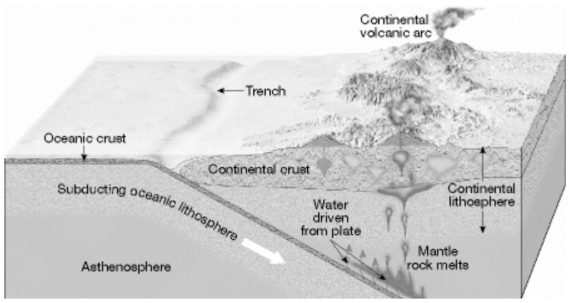Correct Answer

verified
Correct Answer
verified
True/False
Compared to volcanic rocks, plutonic ones have many more crystals in the same volume.
Correct Answer

verified
Correct Answer
verified
Short Answer
What is the average temperature rise below Earth's surface due to the geothermal gradient?
Correct Answer

verified
25 degrees...View Answer
Show Answer
Correct Answer
verified
View Answer
Short Answer
What tabular, nearly horizontal, igneous rock body is intruded concordantly between layers of older sedimentary rock?
Correct Answer

verified
Correct Answer
verified
Essay
In general, what happens in terms of composition as crystallization proceeds down the Bowen's reaction series?

Correct Answer

verified
The early-formed silicates are enriched ...View Answer
Show Answer
Correct Answer
verified
View Answer
Multiple Choice
What do pumice and obsidian have in common?
A) basaltic composition
B) glassy texture
C) ultramafic composition
D) phaneritic texture
Correct Answer

verified
Correct Answer
verified
Multiple Choice
Which of the following best describes an aphanitic texture?
A) The rock is crystalline; mineral grains are too small to be visible without a magnifying lens or microscope.
B) The mineral grains have glassy textures.
C) The rock consists of broken, volcanic-rock and mineral fragments.
D) The rock is crystalline; mineral grains are of distinctly different sizes.
Correct Answer

verified
Correct Answer
verified
Multiple Choice
Exceptionally coarse grained felsic plutonic rocks that are rich in rare minerals and trace elements are probably ________.
A) pegmatites
B) obsidians
C) porphyrys
D) welded tuffs
Correct Answer

verified
Correct Answer
verified
Multiple Choice
Which texture would be most unlikely to occur in an extrusive igneous rock?
A) pyroclastic
B) glassy
C) aphanitic
D) phaneritic
Correct Answer

verified
Correct Answer
verified
Multiple Choice
Name the texture that requires a magnifying glass or microscope to see individual mineral grains.
A) aphanitic
B) porphyritic
C) phaneritic
D) pegmatitic
Correct Answer

verified
Correct Answer
verified
Multiple Choice
What weight percentage of silica (SiO?) typifies granites and rhyolites?
A) 30%
B) 90%
C) 70%
D) 50%
Correct Answer

verified
Correct Answer
verified
Essay
What is the role of water and other volatiles that are driven from the descending plate in the diagram below?

Correct Answer

verified
These volatiles lowe...View Answer
Show Answer
Correct Answer
verified
View Answer
Multiple Choice
Which magma is most likely to quench (congeal) to a natural glass?
A) highly viscous; cools quickly
B) highly viscous; cools slowly
C) highly fluid; cools slowly
D) highly fluid; cools quickly
Correct Answer

verified
Correct Answer
verified
Multiple Choice
Yellowstone National Park is most famous for what?
A) rich copper ore deposits
B) komatiites; ultramafic lavas
C) diamonds in rhyolite veins
D) rhyolitic volcanism
Correct Answer

verified
Correct Answer
verified
Multiple Choice
Magmas rise to shallower depths and intrude the crust or extrude on the surface because ________.
A) of buoyancy, the magmas are hotter and less dense than the surrounding rocks where they form
B) of centrifugal and tidal forces as the Earth spins
C) the pressure at depth is so great that the magmas are forced upwards
D) earthquakes shake the crust and allow the magma to escape upwards
Correct Answer

verified
Correct Answer
verified
Multiple Choice
Intermediate rocks like andesite and diorite ________.
A) are major constituents of the oceanic crust
B) rarely contain plagioclase feldspar, pyroxenes or amphiboles
C) form mainly in convergent continental margins
D) contain the semiprecious gems beryl, topaz, and tourmaline
Correct Answer

verified
Correct Answer
verified
True/False
Intrusive rocks are named for the old God "Trudere".
Correct Answer

verified
Correct Answer
verified
Multiple Choice
The process of ________ is driven by ________ and transforms a magma into an igneous rock.
A) crystallization, cooling (heat loss)
B) intrusion, overlying rock weight
C) partial melting, pressure increase
D) volcanism, internal heating
Correct Answer

verified
Correct Answer
verified
Essay
Briefly explain how magma compositions can change through magma mixing.
Correct Answer

verified
Renewed injection of a primiti...View Answer
Show Answer
Correct Answer
verified
View Answer
Short Answer
________ is a pyroclastic igneous rock with fragments smaller than 2 mm.
Correct Answer

verified
Correct Answer
verified
Showing 101 - 120 of 190
Related Exams